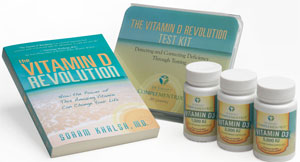Vitamin D Terms
activated vitamin D: also known as 1,25D3 or calcitriol, this form of Vitamin D is a steroid hormone. It is fat soluble and can pass through cell membranes to bind to the Vitamin D receptors. It is a very powerful steroid hormone and it regulates gene expression by being able to switch on and off approximately 200 genes in the body.
angioneogenesis: the process of creating new blood vessels. Cancer cells do this to support their growth.
apoptosis: a type of programmed cell death. Cancer cells lose the ability to program death this helps them to grow uncontrollably.
autocrine: the process whereby a cell makes its own chemical messenger (in this case, activated Vitamin D), that bind to receptors inside the same cell and lead to changes in the biochemical functioning of the cell.
blood level: the amount of Vitamin D in the form of 25D (calcidiol) that circulates in the blood. It is measured in nanograms per milliliter (ng/ml) (or an alternate measure , nanomoles per Litre (nmol/L)) . According to literature referenced in this book, the current “normal” levels for 25D is above 30 ng/ml with 40—70 ng/ml being optimal. Vitamin D blood levels should be tested with a 25-hydroxyvitamin D blood test.
bone mineral density (BMD): the amount of mineral content (calcium) in the bone.
calcidiol: also known as 25D in this book. It is a prehormone made from Vitamin D3 in the blood. This is the form of Vitamin D that must be tested with a 25-hydroxyvitamin D blood test.
calcitriol: see activated vitamin D.
calcium: a mineral necessary for the development of healthy bones. Adequate levels of Vitamin D are necessary to facilitate calcium absorption.
cholecalciferol: known as Vitamin D3 in this book. It is the raw material from which all potent forms of Vitamin D are produced in the body. It is naturally produced in the skin of humans and animals when UVB sunlight hits the skin.
congestive heart failure (CHF): a weakened condition of the heart muscle, impairing its ability to pump blood.
diabetes mellitus: a metabolic disorder , characterized by excess glucose in the blood. It is usually caused by insufficient insulin to carry the glucose into the cells.
endocrine: the process whereby one organ will secrete a molecule (e.g., a hormone) into the bloodstream or lymphatic system, that has an effect on another distant organ, in a different part of the body.
epidemic: an outbreak of illness or disease affecting a large number of people at the same time at unexpected rates.
epidemiological: used to refer to studies that look at the distribution, incidence and cause of disease in specific populations.
ergocalciferol: also known as Vitamin D2, a form of Vitamin D manufactured from plants and fungi. It does not occur naturally in humans and is significantly less potent than naturally occurring Vitamin D3. This form of Vitamin D not recommended for the optimization of Vitamin D levels.
hypertension: another term for high blood pressure.
immune system: the body’s complex mechanism of cells and organs that serve to protect the body from infection with bacteria, parasites, and viruses.
international unit (IU): a unit of measurement based on an accepted standard and based on biological activity of the substance. The IU for Vitamin D is unique to this substance—for example 100 IU of Vitamin D does not equal 100 IU of Vitamin E. 1,000 IU of Vitamin D equals 0.025 nanograms or 25 micrograms (mcg) of Vitamin D.
macrophage: a type of white blood cell that is an important part of the immune response that helps destroy protozoa, bacteria and cancer cells.
malignant: usually used as a synonym for cancer. As in “Malignant tumor”
metastasis: describes the spread of cancer cells through the bloodstream or lymphatic system into other tissues and organs.
minimal erythemal dose (MED): the amount of sun or UV exposure necessary to turn the skin pink in a fair-skinned person.
multiple sclerosis (MS): a degenerative, most likely, autoimmune disease that affects the central nervous system; specifically the myelin that protects the brain and the spinal cord.
nanograms/milliliter (ng/ml): one unit of measurement for the amount of activated Vitamin D in the blood.
nanomoles/litre (nmol/L): another unit of measurement for the amount of activated Vitamin D in the blood. To convert ng/ml to nmol/L multiply by 2.5. (40 ng/ml = 100 nmol/L.)
neuromuscular: having to do with both the nerves and the muscle tissue.
NHANES: National Health and Nutrition Examination Surveys designed to gather health and nutritional information from people from the U.S. for the purpose of medical research, and improving the health of the country.
osteomalacia: known as adult rickets. When adult bones rebuild they do not harden properly resulting in weaker, softer bones. Osteomalacia is associated with deep musculoskeletal pain, and often can be mistaken for fibromyalgia.
osteoporosis: a disease in which the bones do not rebuild as fast as they are broken down and the result is weak, porous bones which are susceptible to fracture. A fracture may be the first indication of this painless disease.
prehormone: a substance secreted by the glands which has little or no biological activity by itself.
recommended daily allowance (RDA): the amount of a nutrient that is deemed necessary to maintain health. The recommendations are made by the Food and Nutrition Board, a unit of the Institute of Medicine, which is part of The National Academy of Sciences. The amounts recommended are intended to meet the nutritional requirements of the vast majority of the healthy population of the U.S.
seasonal affective disorder (SAD): a form of depression that occurs seasonally in the winter months and is associated with low levels of sunlight. It is sometimes referred to as the “winter blues.” Other symptoms of SAD include anxiety, fatigue, headaches, and sleep problems.
secosteroid: a molecule that has a similar structure to a steroid. Vitamin D is our body’s most important secosteroid.
steroid hormone: an important type of hormone that can stimulate receptor molecules and affect gene expression. Steroid molecules have a specific molecular structure that qualifies them to be a steroid.
tuberculosis (TB): a contagious, potentially fatal disease caused by bacteria that usually invades the lungs.
maximum upper limit: an amount set by the government as the recommended maximum levels of a substance to be taken with the intention of eliminating the possibility of any negative health effects.
ultraviolet A (UVA): long rays from the sun and they do not cause sunburn but they penetrate more deeply into your skin and contribute to premature aging, discoloration, and wrinkles.
ultraviolet B (UVB): the rays responsible for turning skin red and causing sunburn. When UVB rays hit the skin, they launch the production of Vitamin D.
vitamin D: a substance produced naturally in the body when skin is exposed to UVB rays. Vitamin D has been associated with the functioning of organs, tissues, and bones as well as the metabolism of calcium and phosphorus in the body.
vitamin D2: see ergocalciferol.
vitamin D3: see cholecalciferol.
vitamin D level: see blood level.
vitamin D receptor (VDR): most tissues and organs in the body have vitamin D receptors giving them the ability to metabolize 25D into activated Vitamin D.
7-dehydrocholesterol: a type of cholesterol in the skin that responds to UVB radiation when the sun hits the skin. It is synthesized into pre-vitamin D3 but in not the activated form of Vitamin D.

